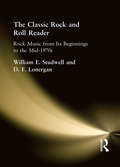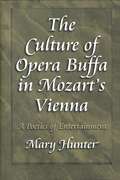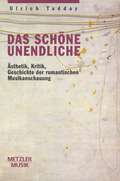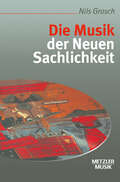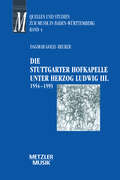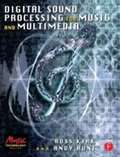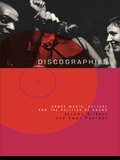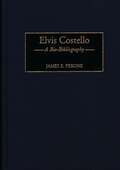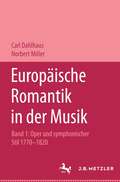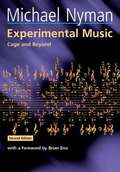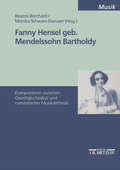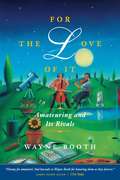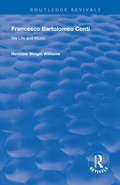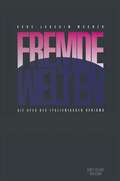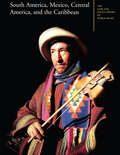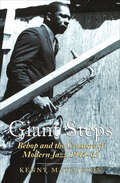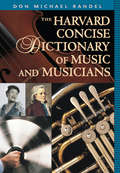- Table View
- List View
The Classic Rock and Roll Reader: Rock Music from Its Beginnings to the Mid-1970s
by William E Studwell David LonerganThe Classic Rock and Roll Reader: Rock Music from Its Beginnings to the Mid-1970s is chock full of entertaining essays to inform and delight you about an era that shaped our culture and future musical trends. This unique book will surprise and enchant even the most zealous music buff with facts and information on the songs that reflected America’s spirit and captured a nation&’s attention. The Classic Rock and Roll Reader is offbeat, somewhat irreverent, ironic, and ancedotal as it discusses hundreds of rock and non-rock compositions included in rock history era. The songs offer you information on: Rock’s Not So Dull Predecessors (for example, “Bewitched, Bothered, and Bewildered” and “The Cry of the Wild Goose”) The Pioneering Rock Songs (such as “Rock Around the Clock” and “Shake, Rattle, and Roll” ) Older Style Songs Amidst the Rocks (for example, “I Could Have Danced All Night” and “Rocky Mountain High” ) The Megastars and Megagroups (such as “Blue Suede Shoes,” “Respect,” and “Surfin’USA” ) The Best Songs that Never Made No. 1 (for example,“ I Feel Good” and “ Tie a Yellow Ribbon Round the Ole Oak Tree” )The Classic Rock and Roll Reader: Rock Music from Its Beginnings to the Mid-1970s also examines the music which preceded early rock, the music which followed early rock, and the numerous non-rock songs which flourished during the classic rock period. A wide spectrum of music is discussed in well over 100 essays on various songs. Musicians, librarians, and the general audience will be taken back to the birth of rock and roll and the various contributing influences. Analyzing each song’s place in rock history and giving some background about the artists, The Classic Rock and Roll Reader offers even the most avid music enthusiast new and unique information in this thorough and interesting guide.
The Classic Rock and Roll Reader: Rock Music from Its Beginnings to the Mid-1970s
by William E Studwell David LonerganThe Classic Rock and Roll Reader: Rock Music from Its Beginnings to the Mid-1970s is chock full of entertaining essays to inform and delight you about an era that shaped our culture and future musical trends. This unique book will surprise and enchant even the most zealous music buff with facts and information on the songs that reflected America’s spirit and captured a nation&’s attention. The Classic Rock and Roll Reader is offbeat, somewhat irreverent, ironic, and ancedotal as it discusses hundreds of rock and non-rock compositions included in rock history era. The songs offer you information on: Rock’s Not So Dull Predecessors (for example, “Bewitched, Bothered, and Bewildered” and “The Cry of the Wild Goose”) The Pioneering Rock Songs (such as “Rock Around the Clock” and “Shake, Rattle, and Roll” ) Older Style Songs Amidst the Rocks (for example, “I Could Have Danced All Night” and “Rocky Mountain High” ) The Megastars and Megagroups (such as “Blue Suede Shoes,” “Respect,” and “Surfin’USA” ) The Best Songs that Never Made No. 1 (for example,“ I Feel Good” and “ Tie a Yellow Ribbon Round the Ole Oak Tree” )The Classic Rock and Roll Reader: Rock Music from Its Beginnings to the Mid-1970s also examines the music which preceded early rock, the music which followed early rock, and the numerous non-rock songs which flourished during the classic rock period. A wide spectrum of music is discussed in well over 100 essays on various songs. Musicians, librarians, and the general audience will be taken back to the birth of rock and roll and the various contributing influences. Analyzing each song’s place in rock history and giving some background about the artists, The Classic Rock and Roll Reader offers even the most avid music enthusiast new and unique information in this thorough and interesting guide.
The Culture of Opera Buffa in Mozart's Vienna: A Poetics of Entertainment
by Mary HunterMozart's comic operas are among the masterworks of Western civilization, and yet the musical environment in which Mozart and his librettist Lorenzo da Ponte wrote these now-popular operas has received little critical attention. In this richly detailed book, Mary Hunter offers a sweeping, synthetic view of opera buffa in the lively theatrical world of late-eighteenth-century Vienna. Opera buffa (Italian-language comic opera) persistently entertained audiences at a time when Joseph was striving for a German national theater. Hunter attributes opera buffa's success to its ability to provide "sheer" pleasure and hence explores how the genre functioned as entertainment. She argues that opera buffa, like mainstream film today, projects a social world both recognizable and distinct from reality. It raises important issues while containing them in the "merely entertaining" frame of the occasion, as well as presenting them as a series of easily identifiable dramatic and musical conventions. Exploring nearly eighty comic operas, Hunter shows how the arias and ensembles convey a multifaceted picture of the repertory's social values and habits. In a concluding chapter, she discusses Cos" fan tutte as a work profoundly concerned with the conventions of its repertory and with the larger idea of convention itself and reveals the ways Mozart and da Ponte pointedly converse with their immediate contemporaries.
The Culture of Opera Buffa in Mozart's Vienna: A Poetics of Entertainment (Princeton Studies in Opera #13)
by Mary HunterMozart's comic operas are among the masterworks of Western civilization, and yet the musical environment in which Mozart and his librettist Lorenzo da Ponte wrote these now-popular operas has received little critical attention. In this richly detailed book, Mary Hunter offers a sweeping, synthetic view of opera buffa in the lively theatrical world of late-eighteenth-century Vienna. Opera buffa (Italian-language comic opera) persistently entertained audiences at a time when Joseph was striving for a German national theater. Hunter attributes opera buffa's success to its ability to provide "sheer" pleasure and hence explores how the genre functioned as entertainment. She argues that opera buffa, like mainstream film today, projects a social world both recognizable and distinct from reality. It raises important issues while containing them in the "merely entertaining" frame of the occasion, as well as presenting them as a series of easily identifiable dramatic and musical conventions. Exploring nearly eighty comic operas, Hunter shows how the arias and ensembles convey a multifaceted picture of the repertory's social values and habits. In a concluding chapter, she discusses Cos" fan tutte as a work profoundly concerned with the conventions of its repertory and with the larger idea of convention itself and reveals the ways Mozart and da Ponte pointedly converse with their immediate contemporaries.
Das schöne Unendliche: Ästhetik, Kritik, Geschichte der romantischen Musikanschauung
by Ulrich TaddayDie Musik gilt seit jeher als die "romantische" Kunst schlechthin. Ähnlich diffus und ahistorisch ist die Verwendung des Begriffs "Romantik" bis heute in der Musikgeschichtsschreibung und Musikwissenschaft. In seiner Diskursgeschichte gibt Ulrich Tadday eine souverän geschriebene und urteilende Darstellung der ästhetischen Wurzeln, Vorstellungen und Nachwirkungen der romantischen Musik.
Die Musik der Neuen Sachlichkeit
by Nils GroschDie Musik der Zwanziger Jahre. Die Komponisten und Musikschriftsteller wollten eine gesellschaftliche Reintegration der Neuen Musik. Auch in der Musik sollte der egalitäre Gedanke der Revolution von 1918/19 umgesetzt werden. Groschs Werk über die Neue Sachlichkeit gibt erstmals eine Darstellung, die die Jahre 1926-1933 in der ganzen Breite des Musiklebens reflektiert.
Die Stuttgarter Hofkapelle unter Herzog Ludwig III. (1554-1593)
by Dagmar Golly-BeckerDie in ihren Anfängen bis in die Mitte des 15. Jahrhunderts zurückreichende Hofmusik der Stuttgarter Residenz erreichte in der zweiten Hälfte des 16. Jahrhunderts unter der Regierung des Herzogs Ludwigs III. einen ersten Höhepunkt. Die Hofkapelle, an der so bedeutende Musiker wie Utz Steigleder und Leonhard Lechner wirkten, war in dieser Zeit auf über fünfzig Migtlieder angewachsen, die neben dem kirchenmusikalischen Dienst immer mehr Repräsentationsaufgaben wahrnahmen. Dagmar Golly-Becker hat diese erste Darstellung der Stuttgarter Hofkapelle am Ende der Renaissance aus den Quellen erarbeitet. Ihre Darstellung gilt den Kapellmeistern, Organisten, Singerknaben, Instrumentalisten und Trompetern und Paukern und damit der sozialen Stellung, die die Musiker am Hof und bei der Kirche innehatten. Darüber hinaus hat sie das zur Aufführung gekommene Repertoire sowie die verwendeten Instrumente erforscht. Die Arbeit beweist, daß sich das Musikleben am Stuttgarter Hof hinter so bedeutenden musikalischen Zentren wie München oder Dresden nicht verstecken muss.
Digital Sound Processing For Music And Multimedia
by Ross Kirk Andy HuntProvides an introduction to the nature, synthesis and transformation of sound which forms the basis of digital sound processing for music and multimedia. Background information in computer techniques is included so that you can write computer algorithms to realise new processes central to your own musical and sound processing ideas. Finally, material is inlcuded to explain the way in which people contribute to the development of new kinds of performance and composition systems. Key features of the book include: · Contents structured into free-standing parts for easy navigation · `Flow lines' to suggest alternative paths through the book, depending on the primary interest of the reader. · Practical examples are contained on a supporting website. Digital Sound Processing can be used by anyone, whether from an audio engineering, musical or music technology perspective. Digital sound processing in its various spheres - music technology, studio systems and multimedia - are witnessing the dawning of a new age. The opportunities for involvement in the expansion and development of sound transformation, musical performance and composition are unprecedented. The supporting website (www. york. ac. uk/inst/mustech/dspmm. htm) contains working examples of computer techniques, music synthesis and sound processing.
Discographies: Dance, Music, Culture and the Politics of Sound
by Jeremy Gilbert Ewan PearsonExperiencing disco, hip hop, house, techno, drum 'n' bass and garage, Discographies plots a course through the transatlantic dance scene of the last last twenty-five years. It discusses the problems posed by contemporary dance culture of both academic and cultural study and finds these origins in the history of opposition to music as a source of sensory pleasure.Discussing such issues as technology, club space. drugs, the musical body, gender, sexuality and pleasure, Discographies explores the ecstatic experiences at the heart of contemporary dance culture. It suggests why politicians and agencies as diverse as the independent music press and public broadcasting should be so hostile to this cultural phenomenon.
Discographies: Dance, Music, Culture and the Politics of Sound
by Jeremy Gilbert Ewan PearsonExperiencing disco, hip hop, house, techno, drum 'n' bass and garage, Discographies plots a course through the transatlantic dance scene of the last last twenty-five years. It discusses the problems posed by contemporary dance culture of both academic and cultural study and finds these origins in the history of opposition to music as a source of sensory pleasure.Discussing such issues as technology, club space. drugs, the musical body, gender, sexuality and pleasure, Discographies explores the ecstatic experiences at the heart of contemporary dance culture. It suggests why politicians and agencies as diverse as the independent music press and public broadcasting should be so hostile to this cultural phenomenon.
Elvis Costello: A Bio-Bibliography (Bio-Bibliographies in Music)
by James E. PeroneThe influential rock musician Elvis Costello is recognized for the impressive breadth and scope of his music. His collaborations with such musicians as Tony Bennett and the Count Basie orchestra, however, attest to the many contradictions that define Elvis Costello, the punk rocker. This important guide to his music and career contains over 800 bibliographic citations and a complete discography of Costello's commercially released recordings. The discography, divided into two sections, separately details Costello's career as performer and composer. A brief biography traces his critically acclaimed career and highlights both the influences on his music and the myriad ways in which his music has influenced others.The vast information compiled in this guide to further research is as interesting and diverse as Costello's career. Rock music scholars, musicologists, and Costello enthusiasts will appreciate the videography/filmography, bibliography of musical scores, and list of electronic resources that supplement the extensive discography and annotated bibliography. A works index and a general index make it easy to cross-reference and locate specific information.
Europäische Romantik in der Musik: Band 1: Oper und symphonischer Stil 1770–1820
by Carl Dahlhaus Norbert MillerStreifzug durch die Geschichte der Musik. Carl Dahlhaus und Norbert Miller erläutern, wie sich die traditionelle Opernform und der neue sinfonische Stil seit 1770 gegenseitig befruchten. Die Geschichte dieser Symbiose ist die Geschichte der klassisch-romantischen Musik als eine einheitliche Epoche. An ausgewählten Ereignissen werden die Umbrüche ebenso wie die kaum merkbaren Veränderungen sichtbar gemacht. Der erste Band setzt ein bei Glucks Musikdramen und belegt die Entwicklung anhand von: Cherubinis Dialogopern, Haydns Bühnenstücke für Eszterháza, Mozart und Da Ponte, die italienische Oper nach Cimarosa und die Anfänge Rossinis mit der kontroversen Debatte über Einzelfragen im Verhältnis von Oper und Symphonie.
Experimental Music: Cage and Beyond (PDF)
by Michael Nyman Foreword by Brian EnoMichael Nyman's book is a first-hand account of experimental music from 1950 to 1970. First published in 1974, it has remained the classic text on a significant form of music making and composing which developed alongside, and partly in opposition to, the post-war modernist tradition of composers such as Boulez, Berio, or Stockhausen. The experimentalist par excellence was John Cage whose legendary 4' 33'' consists of four minutes and thirty three seconds of silence to be performed on any instrument. Such pieces have a conceptual rather than purely musical starting point and radically challenge conventional notions of the musical work. Nyman's book traces the revolutionary attitudes that were developed towards concepts of time, space, sound, and composer/performer responsibility. It was within the experimental tradition that the seeds of musical minimalism were sown and the book contains reference to the early works of Reich, Riley, Young, and Glass.
Fanny Hensel geb. Mendelssohn Bartholdy: Komponieren zwischen Geselligkeitsideal und romantischer Musikästhetik. Internationales Symposion an der Hochschule der Künste Berlin vom 28. - 30. November 1997. M&P Schriftenreihe
First Steps in Music Theory: Grades 1-5
by Eric TaylorThis introduction to essential elements of music is ideal for students preparing for exams, as well as an excellent resource for everyone learning to read music. In this book you will find: • a step-by-step presentation of the basic facts of music theory • a grade-by-grade format • numerous music examples • clear, easily-understood explanations • vital information suitable for music students of all ages and abilities • invaluable support material for Grades 1 to 5 of the ABRSM Music Theory syllabus.
For the Love of It: Amateuring and Its Rivals
by Wayne C. BoothFor the Love of It is a story not only of one intimate struggle between a man and his cello, but also of the larger struggle between a society obsessed with success and individuals who choose challenging hobbies that yield no payoff except the love of it. "If, in truth, Booth is an amateur player now in his fifth decade of amateuring, he is certainly not an amateur thinker about music and culture. . . . Would that all of us who think and teach and care about music could be so practical and profound at the same time."—Peter Kountz, New York Times Book Review "[T]his book serves as a running commentary on the nature and depth of this love, and all the connections it has formed in his life. . . . The music, he concludes, has become part of him, and that is worth the price."—Clea Simon, Boston Globe "The book will be read with delight by every well-meaning amateur who has ever struggled. . . . Even general readers will come away with a valuable lesson for living: Never mind the outcome of a possibly vain pursuit; in the passion that is expended lies the glory."—John von Rhein, Chicago Tribune "Hooray for amateurs! And huzzahs to Wayne Booth for honoring them as they deserve. For the Love of It celebrates amateurism with genial philosophizing and pointed cultural criticism, as well as with personal reminiscences and self-effacing wit."—James Sloan Allen, USA Today "Wayne Booth, the prominent American literary critic, has written the only sustained study of the interior experience of musical amateurism in recent years, For the Love of It. [It] succeeds as a meditation on the tension between the centrality of music in Booth's life, both inner and social, and its marginality. . . . It causes the reader to acknowledge the heterogeneity of the pleasures involved in making music; the satisfaction in playing well, the pride one takes in learning a difficult piece or passage or technique, the buzz in one's fingertips and the sense of completeness with the bow when the turn is done just right, the pleasure of playing with others, the comfort of a shared society, the joy of not just hearing, but making, the music, the wonder at the notes lingering in the air."—Times Literary Supplement
For the Love of It: Amateuring and Its Rivals
by Wayne C. BoothFor the Love of It is a story not only of one intimate struggle between a man and his cello, but also of the larger struggle between a society obsessed with success and individuals who choose challenging hobbies that yield no payoff except the love of it. "If, in truth, Booth is an amateur player now in his fifth decade of amateuring, he is certainly not an amateur thinker about music and culture. . . . Would that all of us who think and teach and care about music could be so practical and profound at the same time."—Peter Kountz, New York Times Book Review "[T]his book serves as a running commentary on the nature and depth of this love, and all the connections it has formed in his life. . . . The music, he concludes, has become part of him, and that is worth the price."—Clea Simon, Boston Globe "The book will be read with delight by every well-meaning amateur who has ever struggled. . . . Even general readers will come away with a valuable lesson for living: Never mind the outcome of a possibly vain pursuit; in the passion that is expended lies the glory."—John von Rhein, Chicago Tribune "Hooray for amateurs! And huzzahs to Wayne Booth for honoring them as they deserve. For the Love of It celebrates amateurism with genial philosophizing and pointed cultural criticism, as well as with personal reminiscences and self-effacing wit."—James Sloan Allen, USA Today "Wayne Booth, the prominent American literary critic, has written the only sustained study of the interior experience of musical amateurism in recent years, For the Love of It. [It] succeeds as a meditation on the tension between the centrality of music in Booth's life, both inner and social, and its marginality. . . . It causes the reader to acknowledge the heterogeneity of the pleasures involved in making music; the satisfaction in playing well, the pride one takes in learning a difficult piece or passage or technique, the buzz in one's fingertips and the sense of completeness with the bow when the turn is done just right, the pleasure of playing with others, the comfort of a shared society, the joy of not just hearing, but making, the music, the wonder at the notes lingering in the air."—Times Literary Supplement
For the Love of It: Amateuring and Its Rivals
by Wayne C. BoothFor the Love of It is a story not only of one intimate struggle between a man and his cello, but also of the larger struggle between a society obsessed with success and individuals who choose challenging hobbies that yield no payoff except the love of it. "If, in truth, Booth is an amateur player now in his fifth decade of amateuring, he is certainly not an amateur thinker about music and culture. . . . Would that all of us who think and teach and care about music could be so practical and profound at the same time."—Peter Kountz, New York Times Book Review "[T]his book serves as a running commentary on the nature and depth of this love, and all the connections it has formed in his life. . . . The music, he concludes, has become part of him, and that is worth the price."—Clea Simon, Boston Globe "The book will be read with delight by every well-meaning amateur who has ever struggled. . . . Even general readers will come away with a valuable lesson for living: Never mind the outcome of a possibly vain pursuit; in the passion that is expended lies the glory."—John von Rhein, Chicago Tribune "Hooray for amateurs! And huzzahs to Wayne Booth for honoring them as they deserve. For the Love of It celebrates amateurism with genial philosophizing and pointed cultural criticism, as well as with personal reminiscences and self-effacing wit."—James Sloan Allen, USA Today "Wayne Booth, the prominent American literary critic, has written the only sustained study of the interior experience of musical amateurism in recent years, For the Love of It. [It] succeeds as a meditation on the tension between the centrality of music in Booth's life, both inner and social, and its marginality. . . . It causes the reader to acknowledge the heterogeneity of the pleasures involved in making music; the satisfaction in playing well, the pride one takes in learning a difficult piece or passage or technique, the buzz in one's fingertips and the sense of completeness with the bow when the turn is done just right, the pleasure of playing with others, the comfort of a shared society, the joy of not just hearing, but making, the music, the wonder at the notes lingering in the air."—Times Literary Supplement
Francesco Bartolomeo Conti: His Life and Music (Routledge Revivals)
by Hermine Weigel WilliamsFirst Published in 1999, Hermine Weigel Williams’ study draws on more than thirty years of research to fill this noticeable lacuna , and presents here the first full scale life and works of the composer for over ninety years. Part One of the book surveys the biographical aspects of Conti’s career. Appointed court theorist at the age of nineteen, Conti was promoted to court composer in 1713-14. Williams examines Conti’s creative collaborations with some of the leading poet-librettists of the day, and the influence of his music that can be identified in works by Telemann, Bach and Handel. Part Two comprises close analyses of Conti’s compositions: his instrumental music, cantatas, operas, intermezzos, oratorios and sacred music. Williams reveals Conti as a composer who constantly experimented with a wide range of French, German and Italian ideas and techniques to create his own diverse musico-dramatic style.
Francesco Bartolomeo Conti: His Life and Music (Routledge Revivals)
by Hermine Weigel WilliamsFirst Published in 1999, Hermine Weigel Williams’ study draws on more than thirty years of research to fill this noticeable lacuna , and presents here the first full scale life and works of the composer for over ninety years. Part One of the book surveys the biographical aspects of Conti’s career. Appointed court theorist at the age of nineteen, Conti was promoted to court composer in 1713-14. Williams examines Conti’s creative collaborations with some of the leading poet-librettists of the day, and the influence of his music that can be identified in works by Telemann, Bach and Handel. Part Two comprises close analyses of Conti’s compositions: his instrumental music, cantatas, operas, intermezzos, oratorios and sacred music. Williams reveals Conti as a composer who constantly experimented with a wide range of French, German and Italian ideas and techniques to create his own diverse musico-dramatic style.
Fremde Welten: Die Oper des italienischen Verismo
by Hans-Joachim WagnerMit diesem Buch erfährt der Opernverismo erstmals eine umfassende Gesamtdarstellung. Die Rahmenbedingungen für seine Durchsetzung im internationalen Opernbetrieb werden ebenso in den Blick genommen wie die Entstehung, Verbreitung und Rezeption der veristischen Oper.
The Garland Encyclopedia of World Music: South America, Mexico, Central America, and the Caribbean (Garland Encyclopedia of World Music)
by Dale A. Olsen Daniel E. SheehyFirst published in 1999. Routledge is an imprint of Taylor & Francis, an informa company.
The Garland Encyclopedia of World Music: South America, Mexico, Central America, and the Caribbean (Garland Encyclopedia of World Music)
by Dale A. Olsen and Daniel E. SheehyFirst published in 1999. Routledge is an imprint of Taylor & Francis, an informa company.
Giant Steps: Bebop And The Creators Of Modern Jazz, 1945-65 (Scene Ser.)
by Kenny MathiesonGiant Steps examines the most important figures in the creation of modern jazz, detailing the emergence of bebop through the likes of Dizzy Gillespie, Charlie Parker, Fats Navarro, Bud Powell and Thelonious Monk. Using this as its starting point, Giant Steps subsequently delves into the developments of jazz composition, modal jazz and free jazz. The music of each of these great masters is examined in detail and will provide both a fine introduction for the large audience newly attracted to the music but unsure of their direction through it, as well as an entertaining and informative read for those with a more substantial background.
The Harvard Concise Dictionary of Music and Musicians (Economics And Business Victorian Curriculum Ser. #17)
by Don Michael RandelThis new compact guide to the history and performance of music is both authoritative and a pleasure to use. With entries drawn and condensed from the widely acclaimed Harvard Dictionary of Music (now in its fourth edition) and its companion The Harvard Biographical Dictionary of Music, it is a dependable reference for home and classroom and for professional and amateur musicians. This concise dictionary offers definitions of musical terms; succinct characterizations of the various forms of musical composition; entries that identify individual operas, oratorios, symphonic poems, and other works; illustrated descriptions of instruments; and capsule summaries of the lives and careers of composers, performers, and theorists. Like its distinguished parent volumes, The Harvard Concise Dictionary of Music and Musicians provides information on all periods in music history, with particularly comprehensive coverage of the twentieth century. Clearly written and based on vast expertise, The Harvard Concise Dictionary of Music and Musicians is an invaluable handbook for everyone who cares about music.
